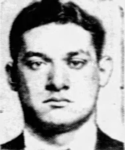 New York Daily News, January 27, 1939 The Boulevard Restaurant (referred to locally as the “Dutchman’s”), a New York City coffee house and known gambling spot, was robbed in March 1937. Following the robbery, Detective Michael J. Foley and his partner, John R. Gallagher, made frequent patrol visits to the Dutchman’s, believing it was vulnerable to another robbery.
Around 3:20 a.m. on April 10, 1937, Foley and Gallagher were there when several armed men entered and declared a robbery. Foley and Gallagher fired at the robbers, wounding one. Foley was also shot in the exchange of gunfire, and he died eighteen hours later. The injured robber, Joseph Harvey O’Loughlin, survived. Gallagher and other arriving police officers arrested two of other robbers at the scene – Arthur Friedman and Dominick Guariglia.
Police interrogated O’Loughlin, Guariglia, and Friedman in an effort to learn the names of other individuals involved in the robbery. Soon, they implicated Philip Chaleff, Benjamin Ertel, and Isidore Perlmutter as well. Murder charges were filed against O’Loughlin, Guariglia, Friedman, and Chaleff less than two weeks after the shooting. Police continued their interrogations in an effort to learn the source of the guns, including the murder weapon, and the name of 19-year-old Isidore “Izzy” Zimmerman came up.
Zimmerman was a local high school senior with a football scholarship to Columbia University. Danny Rose and “Popeye” Cooperman, two other young men who traveled in the same social circle as the men charged with the murder, told police that Zimmerman supplied the guns used in the robbery. On June 21, 1937, Perlmuter, Ertel, and Zimmerman were charged in the crime as well. Rose and Cooperman were not charged despite admitting involvement. Police were unable to apprehend Ertel and Perlmuter.
In April 1938, Zimmerman went to trial with Friedman, O’Loughlin, Guariglia, and Chaleff. Zimmerman was charged with supplying the guns, while the other four were charged with carrying out the robbery. Zimmerman’s attorney, James Murray, sought a separate trial for Zimmerman, but the judge refused. Zimmerman testified at the trial and denied any involvement.
On April 15, 1938, Zimmerman and his co-defendants were convicted of first-degree murder. Under New York’s felony murder law, all five men were considered equally guilty of murder, and they were all sentenced to death. The convictions were affirmed on appeal in December 1938. The mothers of the five young men made newspaper headlines when they offered to exchange their own lives for those of their sons and blamed the harsh slum conditions of their neighborhood for their sons’ criminal activities. New York Governor Herbert H. Lehman granted a hearing to the mothers in January 1939.
On January 26, 1939, Zimmerman was hours away from his execution, his head shaved in preparation, when Governor Lehman commuted his death sentence to life in prison. Governor Lehman’s basis for commuting Zimmerman’s sentence was his concern that Zimmerman’s conviction rested largely on the testimony of Danny Rose and “Popeye” Cooperman – admitted, but unindicted accomplices. The death sentence of Philip Chaleff, who had become extremely ill from complications of diabetes, was commuted to a life sentence as well. Joseph O’Loughlin, Dominick Guariglia and Arthur Friedman were executed later the same day.
Years later, Zimmerman told his story to attorney Maurice Edelman, who agreed to take on Zimmerman’s case without payment. Edelman successfully appealed Zimmerman’s conviction on the basis that Rose had falsely testified during the trial. Not only had Rose perjured himself by testifying that he had not made any pretrial statements, Rose’s inconsistent and previously undisclosed pretrial statements actually corroborated Zimmerman’s claims of innocence. The court held that the failure of the prosecution to correct this false testimony had resulted in an unfair trial for Zimmerman. The charges against him were vacated and dismissed by Judge Thomas Dickens, and he was released on February 2, 1962 after 24 years in prison.
In May 1962, Zimmerman filed a lawsuit against New York City, seeking $1 million in damages. This lawsuit was dismissed when a judge ruled that he had not shown that the prosecution had caused his conviction by suppressing evidence. Zimmerman then filed a second lawsuit against the city, but that too was dismissed in 1966 with the court finding that Zimmerman’s remedy, if any, would lie with the legislature. In June 1964, Zimmerman published his prison memoir, Punishment Without Crime, to tell his story.
Zimmerman spent the next two decades struggling to find employment – a struggle he attributed to his criminal record – and continuing to seek compensation from the state. Finally, in July 1981, New York Governor Hugh Carey signed legislation that allowed Zimmerman to sue the State of New York for damages.
In 1983, more than two decades after his release, New York State’s Court of Claims awarded him $1,007,763.75 for “loss of earnings, medical expenses, loss of liberty and civil rights, loss of reputation and mental anguish.” Just four months later, Zimmerman suffered a massive heart attack and died at the age of 66.
– Meghan Barrett Cousino
|